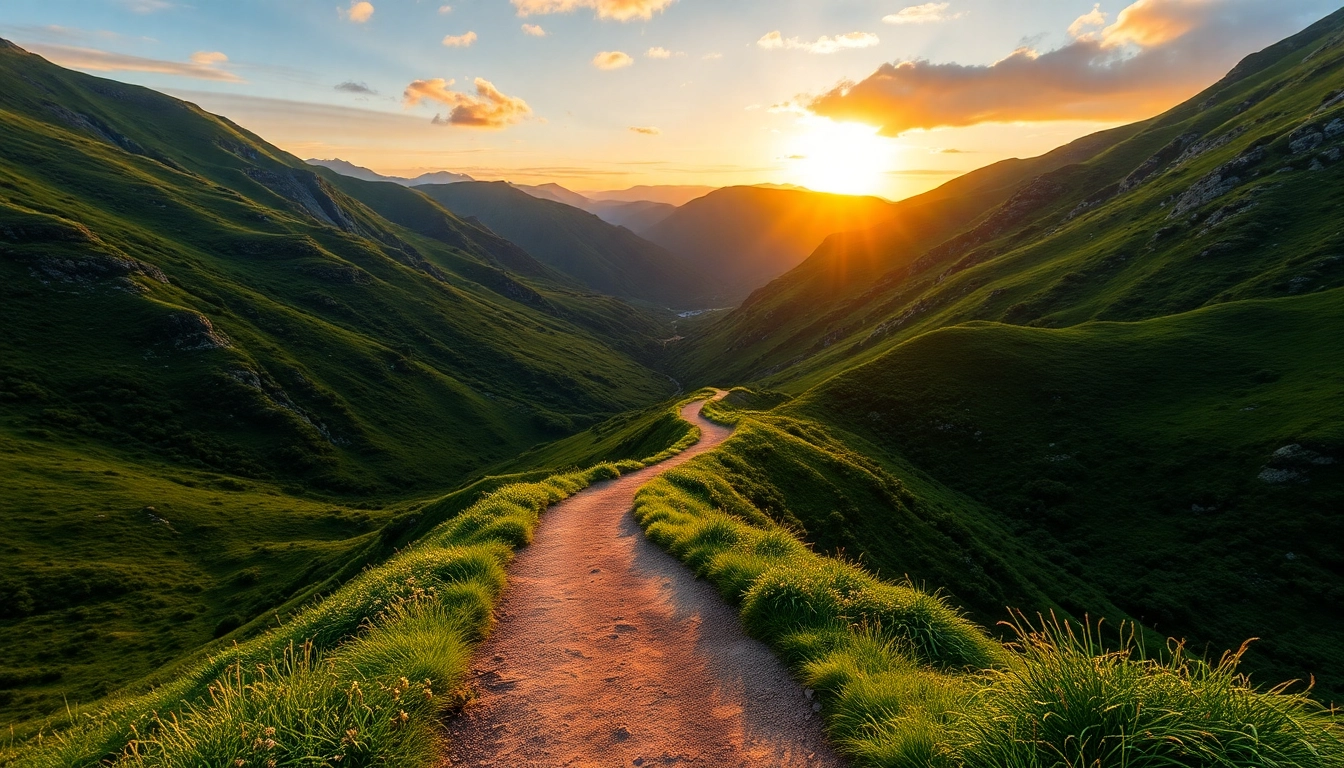Introduction to Hiking: Understanding the Basics
Hiking is more than just a leisurely walk; it is an immersive outdoor activity that offers profound physical, mental, and spiritual benefits. Whether traversing lush forests, rugged mountains, or serene coastal trails, a hike encourages explorers to connect deeply with nature while advancing their fitness and well-being. As an ancient activity rooted in survival and exploration, hiking has evolved into a popular recreational pursuit enjoyed worldwide. Its accessibility makes it an ideal form of exercise that combines adventure, relaxation, and environmental appreciation.
Understanding the essence of hiking involves grasping its core definition, benefits, historical development, and various types tailored to different terrains and preferences. This comprehensive guide aims to unveil the many dimensions of hiking, offering valuable insights for beginners and seasoned enthusiasts alike. From planning your journey to exploring top destinations, we provide practical tips and expert advice to elevate your outdoor experience to new heights.
What Defines a Hike and Its Benefits
Definition of a Hike
A hike is typically characterized as a long, vigorous walk on natural trails, footpaths, or rugged terrains. Unlike casual strolling, hiking often involves traversing challenging environments – steep inclines, uneven paths, rocky surfaces, and forested areas. The term encompasses both recreational outdoor activity and a form of exercise that promotes cardiovascular health, muscular endurance, and mental clarity. According to Merriam-Webster, to hike means “to walk or march a great distance, especially through rural areas, for pleasure or exercise,” capturing the activity’s essence in both recreational and physical terms.
Physical and Mental Benefits
Hiking provides numerous health advantages supported by scientific research. Regular hiking improves cardiovascular fitness, strengthens muscles, and enhances balance and coordination. It is also an effective way to manage weight, lower blood pressure, and boost immune function. Moreover, the activity’s immersive nature fosters mental well-being—reducing stress, alleviating symptoms of depression, and increasing overall happiness.
Beyond physical health, hiking nurtures a spiritual connection with nature, encourages mindfulness, and promotes environmental stewardship. Scientific studies demonstrate that time spent in green spaces elevates mood and cognitive function while reducing anxiety.
Historical Evolution of Hiking as a Recreational Activity
Origins and Cultural Significance
Hiking has ancient origins, evolving from early humans’ need for exploration and survival. As societies transitioned from nomadic lifestyles to settled civilizations, walking remained a vital mode of transportation, defense, and trade. Over centuries, this practical activity gradually transformed into a leisure pursuit, especially in European countries during the 18th century, when the Romantic movement emphasized nature appreciation and rural landscapes.
In the 19th and 20th centuries, hiking gained momentum as part of outdoor recreation, with the establishment of national parks, hiking clubs, and trail systems. Pioneering figures like John Muir and the Sierra Club profoundly influenced environmental conservation and outdoor ethics, fostering a culture that celebrates hiking as a means of appreciating natural beauty and promoting conservation efforts.
Modern Development and Global Popularity
Today, hiking is recognized worldwide as an accessible, healthful activity suitable for all ages and skill levels. Technological advancements—such as trail mapping apps, GPS devices, and specialized gear—have made planning and embarking on hikes safer and more enjoyable. Major global destinations, from the Appalachian Trail in the United States to the Inca Trail in Peru and Indonesia’s rugged terrain, attract millions of hikers annually, further embedding hiking into global tourism and healthy lifestyle trends.
Common Types of Hikes and Suitable Terrain
Day Hikes vs. Backpacking
Day hikes are short excursions typically lasting a few hours, perfect for beginners or those with limited time. They often take place on well-marked trails near popular parks or scenic areas. Conversely, backpacking involves multi-day trips with overnight stays, requiring more extensive planning, gear, and stamina. Backpackers traverse higher elevations, remote wilderness, and challenging terrains, experiencing the full immersion of nature.
Trail Classifications and Terrain Types
Hiking trails are classified based on difficulty—ranging from easy paths suitable for families to demanding routes for experienced adventurers:
- Easy Trails: Flat or gently rolling terrain with well-maintained paths, accessible for beginners and children.
- Moderate Trails: Include some elevation gains, narrow paths, and uneven surfaces, requiring basic fitness and coordination.
- Strenuous Trails: Steep inclines, rocky or technical terrain, and significant altitude changes; suited for seasoned hikers.
Types of terrain include:
- Forests and woodlands
- Mountainous and high-altitude regions
- Coastal trails along beaches and cliffs
- Desert terrains with unique flora and fauna
Choosing the appropriate trail depends on your experience, fitness level, and personal goals for the hike.
Planning Your Perfect Hike: Preparation and Safety
Selecting the Right Route and Difficulty
Effective preparation begins with selecting a trail that matches your fitness level and expectations. Use reputable sources such as national park websites, local hiking guides, or trail apps to identify suitable routes. Consider factors like distance, elevation gain, trail condition, and accessibility. For beginners, starting with shorter, flat routes ensures confidence-building and enjoyment.
Advanced hikers seeking challenge can explore strenuous routes with rugged terrain or remote wilderness areas. Always review trail maps, elevation profiles, and recent trail conditions to make informed decisions. Consulting local outdoor stores or hiking clubs can provide valuable insights.
Essential Gear and Packing Tips
Preparing the right gear is crucial for safety and comfort. Basic items include:
- Appropriate footwear—sturdy hiking boots or shoes with good traction
- Weather-appropriate clothing—layered options, waterproof jackets, sun protection
- Navigation tools—compass, GPS device or smartphone with offline maps
- Hydration and nutrition—water bottles or hydration packs, high-energy snacks
- First aid kit—bandages, antiseptic wipes, blister treatment
- Safety equipment—whistle, multi-tool, flashlight or headlamp
- Additional items for backpacking—tent, sleeping bag, cooking gear
Always pack light yet comprehensively, and tailor your gear to the specific trail conditions and duration.
Safety Measures and Emergency Preparedness
Safety hinges on proper planning and awareness of potential risks. Before starting your hike:
- Inform someone about your itinerary and expected return time
- Check weather forecasts and trail conditions
- Carry a fully charged communication device and power bank
- Stay on marked trails to avoid getting lost
- Recognize local wildlife and maintain a safe distance
- Prepare for emergencies—know basic first aid, carry a whistle, and understand rescue procedures
In remote areas, consider carrying a personal locator beacon (PLB) or satellite messenger for added safety.
Hiking Techniques and Skills for All Levels
Navigation and Trail Marking
Basic navigation skills are essential for safe hiking. Use trail markers, cairns, natural features, and maps to stay on course. For advanced navigation, learn to interpret topographic maps and use a compass. Smartphone apps with offline maps are invaluable but should not replace traditional skills due to potential signal loss.
Trail marking awareness helps prevent disorientation, especially in dense forests or mountain passes. Recognizing signs such as color-coded blazes, signs, and trail intersections ensures that you remain oriented.
Proper Hiking Posture and Breathing
Adopting correct posture reduces fatigue and injury risk. Keep your back straight, shoulders relaxed, and knees slightly bent. Engage core muscles to maintain stability, especially on uneven terrain.
Breathing techniques enhance endurance—inhale deeply through your nose, filling your diaphragm, and exhale steadily. Rhythmic breathing helps conserve energy and manage exertion during steep climbs.
Managing Fatigue and Staying Hydrated
Recognize signs of fatigue: heavy legs, decreased concentration, and irritability. Pace yourself accordingly, taking regular breaks to rest and refocus. Maintaining hydration is critical; aim to drink small amounts frequently rather than large quantities sporadically. Adding electrolytes to water can replenish mineral losses during vigorous activity.
Nutrition also plays a vital role—snacks like nuts, dried fruits, and energy bars sustain energy levels over extended hikes.
Top Hike Destinations in Indonesia and Worldwide
Iconic Trails in Indonesia: From Bali to Java
Indonesia offers a diverse array of hiking experiences, with its rich cultural heritage and stunning landscapes. Notable trails include:
- Kawah Ijen Volcano: Famous for its azure crater lake and mesmerizing blue flames, this hike offers both natural beauty and a challenging ascent.
- Mount Rinjani: Indonesia’s second-highest volcano, Rinjani attracts adventurous hikers aiming to summit its impressive peak amid geothermal springs and crater lakes.
- Bromo Tengger Semeru National Park: Known for sunrise views and surreal volcanic landscapes, this accessible trail offers breathtaking vistas.
- Gunung Halimun Salak National Park: Encompassing dense rainforests and waterfalls, it provides immersive jungle trekking.
Each of these destinations showcases Indonesia’s natural diversity, from tropical forests to volcanic terrains, making it a prime region for both novice and experienced hikers.
Popular Global Hiking Spots for Adventure Seekers
Worldwide, several iconic trails beckon explorers:
- Appalachian Trail (USA): Spanning over 2,190 miles, this historic trail traverses the Appalachian Mountains from Georgia to Maine, providing varied scenery and a supportive hiking community.
- Inca Trail (Peru): Famous for Machu Picchu views, this trail combines archaeological wonders with rugged mountain landscapes.
- Torres del Paine (Chile): A trek through Patagonian wilderness boasting glaciers, mountains, and lakes.
- Tour du Mont Blanc (Europe): A classic traverse through France, Italy, and Switzerland, offering alpine panoramas and cultural richness.
Choosing a global destination depends on your desired experience, seasonal conditions, and skill level. Many of these trails are best undertaken with prior planning and possibly guided support.
Seasonal Best Practices for Hike Planning
Seasonality profoundly impacts hiking safety and enjoyment:
- Spring: Blooming flora and flowing waterfalls create scenic vistas. Be aware of muddy trails and unpredictable weather.
- Summer: Longer days and warmer weather facilitate extended hikes. Watch for heat exhaustion and dehydration; carry adequate water and sun protection.
- Autumn: Cooler temperatures and colorful foliage enhance trail beauty. Prepare for early sunsets and chilly mornings.
- Winter: Snow and ice demand specialized gear like crampons and cold-weather clothing. Some trails may be closed; always check trail conditions and advisories.
Enhancing Your Hiking Experience: Community, Apps, and Sustainability
Joining Hiking Groups and Community Events
Engaging with local or global hiking communities enriches the outdoor experience. Joining groups fosters motivation, safety, and shared knowledge. Community events like organized hikes, conservation projects, and trail cleanup initiatives promote camaraderie and environmental responsibility. Platforms such as Meetup or social media groups connect hikers of all levels, facilitating information exchange and friendship-building.
Useful Apps and Tools for Hikers
Modern technology offers invaluable assistance for planning, navigating, and recording hikes. Essential apps include:
- Trail mapping and offline navigation apps like AllTrails or Gaia GPS
- Weather forecasting tools to monitor conditions dynamically
- Fitness trackers and GPS watches to log distances, elevation, and pace
- Community platforms for reviews, trail tips, and safety alerts
Ensure your devices are fully charged and backed up, and familiarize yourself with their features before heading out.
Environmentally Responsible Hiking and Leave No Trace Principles
Sustainable hiking practices help preserve natural resources for future generations. Adhere to Leave No Trace principles, which include:
- Planning ahead to minimize impact
- Traveling and camping on durable surfaces
- Properly disposing of waste and minimizing campfire impacts
- Respecting wildlife and other visitors
- Being considerate of the environment and local cultures
Responsible hiking not only reduces environmental degradation but also enriches the outdoor experience through a stronger connection and stewardship spirit.

